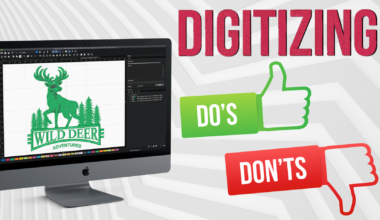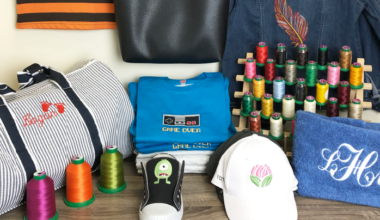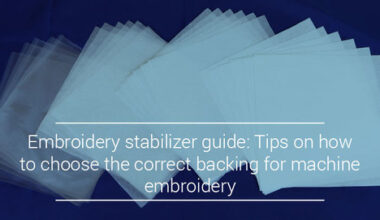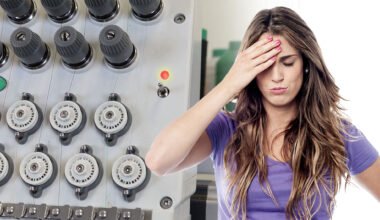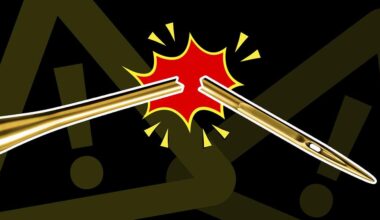You know that feeling when you get an embroidery machine and all you want to do is stitch anything and everything you get your hands on?
Even when you know it isn’t necessarily “machine-embroidery-friendly,” you still try to find a way to hoop the impossible and experiment with tons of different materials until you make it happen.
However, some projects require specific practices and tools. In this article, we’ll share how you can embroider nine creative machine embroidery projects – no matter how difficult they appear to be.
Whether you’ve had trouble embroidering these projects in the past or have yet to attempt them, you’ll learn the tools and tips you need to effectively embroider these nine projects.
#9: Jacket backs
In order to embroider a jacket back, you’ll need a hoop that is at least 10 inches wide or larger. Many multi-needle machines include hoops this large with the purchase of the machine. A large, high-stitch-count design such as this feather design on the back of this jacket will also require cut-away stabilizer due to its complexity.
Cutaway stabilizer supports stitches better than tear-away stabilizer, as it is the strongest of all stabilizer choices. Because jackets are usually heavier and thus require more support, you can use a table attachment like the one shown in the video that grants support below the hoop on large, heavy items. A heavy jacket like this would also require a larger needle, such as an 80/12 needle.Did you know? Using the right materials can make all the difference in your embroidery designs. Click here to learn all about different embroidery fabrics and the best materials to use on each.
#8: Caps
Caps are best achieved with a multi-needle embroidery machine. Unfortunately, due to their size, you can’t embroider on structured caps with a single-needle for two reasons:
- You can’t get a structured hat to be flat, like you can with an unstructured hat.
- They are not compatible with round cap hoops.
While you can embroider on structured caps with specialty frames, the best way to embroider on a structured cap is with a rounded cap attachment. These are either included with the purchase of a multi-needle embroidery machine or are priced separately depending on the company you purchase from.
While some embroiderers shy away from caps due to lack of experience using different hoops, cap attachments are designed to make cap embroidery easy.
In fact, you can schedule a free virtual demo to see how cap embroidery is done. All you have to do is place the stabilizer inside the cap, place the cap on the cap hoop and close it together.
Did you know? There are also specialty cap frames like the Hooptech Gen 2 cap frames that make cap hooping even easier. The Gen 2 works to help ease cap embroidery issues and shorten the learning curve usually associated with cap embroidery. Click here to learn more about the Gen 2 cap frame.
#7: Portraits
While embroidering portraits won’t require the use of specialty frames, they will require two things:
- Multiple colors to make your portrait pop
- Specialty needles and threads
Because portraits usually have very fine details, you’ll need to use a smaller needle and thinner weight thread to allow all the details to show up clearly. Depending on how intricate the details are, you may need a size 50 or 60-weight thread.
You may also need a 70/10 or 65/9 needle depending on the size of the stitches. You’ll also need to have plenty of thread colors in stock and (preferably) ready to go on your machine.
Did you know? Multi-needle embroidery machines are more accessible today than ever. You can get started with a multi-needle for a little over $100 a month.
#6: Sunhats
While the brim of sunhats are flatter and easier to embroider, you probably won’t have much luck embroidering on the head of a sunhat unless…You have machine embroidery clamps!
Machine embroidery clamps hold down all kinds of thick and unusually shaped materials with high-pressure clamps that keep the material flat and stable enough for machine embroidery.
Unfortunately, these specialty clamps are only compatible with multi-needle machines, so you may be limited to embroidering on the brim of the sunhat if you’re a single-needle user. When embroidering on textured materials like this straw hat, you’ll need to use a stabilizer on the bottom side of the design and a heavy water soluble stabilizer above the design to keep the stitches from sinking into the fabric.
Pro tip: You can purchase fabric markers designed specifically for embroidery to help fill in any gaps left on textured materials like this sunhat.
#5: Duffel bags
To successfully embroider a large duffel bag without un-sewing and re-sewing, you’ll need a few important tools:
- An embroidery machine with clearance underneath the machine head: As the machine head moves, the bag needs room to move around as well. Otherwise, you’ll be left with a very limited embroidery area.
- Magnetic hoops: With these hoops, you can easily hoop and embroider thick materials without any issues.
Pro tip: If your bag is composed of thick material, you may also want to consider using a larger needle that won’t break on tough materials. Consider using an 80/12 or 90/14 needle. Titanium coated needles are a great choice for tough materials and will last longer than standard needles.
#4: Belts/Sashes
In Embroidery 101, we learned that the fabric and stabilizer should cover all areas of the hoop in order to get high quality embroidery and prevent loss of registration. However, it’s impossible to follow this advice with belt-shaped items on a regular hoop.
The video below shows two ways to embroider on sashes. As you can see, you can pull it off using a square hoop with a few extra steps and a large hoop that’s at least 10 inches wide.
Pro tip: If you want to embroider on thick leather belts, you need an embroidery machine that is compatible with commercial attachments like the Belt Hoop, which is designed with high-pressure clamps that allow you to get a firm hold on thick belts.
If you have a multi-needle, you can also use a belt hoop. A belt hoop includes high-pressure clamps that allow you to embroider thick belts without having to float it over your hoop and run the risk of losing registration.
#3: Shoes
If you have a multi-needle, you can use specialty hoops to embroider irregularly-shaped finished goods like shoes.
The embroidery market has plenty of specialty hoops for shoes specifically, but they tend to be pretty costly. For a fraction of the price, you can embroider on the tongue of sneakers or on the front of flats with an 8-in-1 hoop.
This hoop consists of different sized frames that are small enough to fit into difficult-to-hoop areas such as the tongue of sneakers. They are also versatile enough to work on plenty of other hard-to-reach areas like collars, pockets and more.
The 8-in-1’s smallest frame allows you to easily float the shoe over the hoop. All you’ll need is some adhesive stabilizer to support the shoe and avoid registration issues. As you can see in the video above, with a multi-needle machine, you have the space underneath the hoop, giving the shoe ample room to move around as the machine stitches.
Did you know? The 8-in-1 hoop consists of different sized frames that are small enough to fit into difficult-to-hoop areas such as the tongue of sneakers. They are also versatile enough to work on plenty of other hard-to-reach areas like collars, pockets and more. Click here to learn more about the 8-in-1 hoop set.
#2: Boots
Because the material on boots is usually very thick, it’s hard to hoop them without leaving marks. Therefore, you have two options:
- Floating the material over your hoop: When you float your material, you do not hoop the actual material. Instead, hoop the stabilizer and place your material above the stabilizer outside of the hoop. You will also need to use some adhesive spray and pins to secure the material to the stabilizer. Once the machine embroiders enough stitches, it will assist in holding the material down. The problem with floating is that there is more “machine babysitting” involved, and you can also run the risk of embroidering off-center or losing registration as the material isn’t as secure as it would be in the hoop. You can also use specialty attachments like the 8-in-1 hoop set to easily float items you can’t hoop.
Click here to learn more about the 8-in-1 hoop set.
- Magnetic hoops: Magnetic hoops like Mighty Hoops reduce the possibility of hoop marks since they have powerful magnets that bind the top and bottom hoop together effortlessly. This also allows you to hoop thick materials with ease. Luckily, these hoops are available on a wide variety of multi-needle embroidery machines and can be adjusted to fit your machine.
Click here to learn more about Mighty Hoops.
Pro tip: To embroider on boots, you’ll need a tough needle like an 80/12 needle or a titanium needle.
#1: In-the-hoop projects
In-the-hoop embroidery is a fast and easy way to create a finished item out of a simple piece of fabric. In order to embroider an in-the-hoop stuffed animal like this one, you’ll need a large enough hoop to create an item that is large even when sewn together.
Although there are smaller in-the-hoop projects available for single-needle users, the best way to create a large stuffed animal directly on your embroidery machine is with a hoop that is at least 12 inches wide.
Pro tip: Stuffed animals aren’t the only item you can create in-the-hoop. You can stitch everything from baby bibs to key chains from scratch using your embroidery machine.
And that’s it! Easy peasy, right?
For more embroidery project ideas, click here to check out our library of video tutorials.
As you witnessed in this blog, the right tools help make embroidery on almost anything possible. But you don’t have to take my word for it…
Meet Linda Russell

Linda got started with a simple domestic single-needle. When she decided she wanted to take her hobby to the next level, Linda decided to jump into a multi-needle. Shortly after, Linda was embroidering large, multi-color designs in minutes. She even began experimenting with other types of projects she was never able to accomplish on her single-needle. You can watch Linda share her project ideas and embroidery journey here. You’ll also meet a few other embroiderers who got started with no experience whatsoever.
Click here to check out how they’re doing now.
You can also schedule a free virtual demo if you want to see the exact same machine Linda uses in action. In it, you can ask any questions you have about the industry and see exactly how to start and run an embroidery project in real time.
Want to see one of our machines in action?
Schedule a free virtual demo if you want to see any of our machines in action. In it, you can ask any questions you have about the industry and see exactly how to start and run an embroidery project in real time.


